

5 Tips for keeping kids active throughout the day. It doesn’t take many weeks into the school year before you start noticing a change in your students.
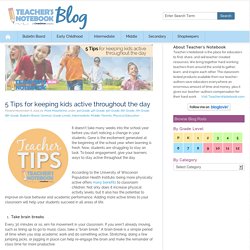
Gone is the excitement generated at the beginning of the school year when learning is fresh. Now, students are struggling to stay on task. To boost engagement, give your learners ways to stay active throughout the day. According to the University of Wisconsin Population Health Institute, being more physically active offers many benefits to classroom children.
Not only does it increase physical activity levels, but it also has the potential to improve on-task behavior and academic performance. Take brain breaks Every 30 minutes or so, aim for movement in your classroom. TRANSITION TIPS & BRAIN BREAK IDEAS TO INCREASE ENGAGEMENT. Why Crossing the Midline Activities Helped this Child Listen to his Teacher - Integrated Learning Strategies. As I think back to the time when I was in kindergarten, I realize how much has changed. What was once naptime, coloring, painting, and running around the playground at recess, is now a place for reading, writing, sitting still in your chair and an introduction to math facts. Even preschool is now more focused on academics and many of them tailor their lesson plans to higher learning subjects that normally wouldn’t begin until kindergarten or first grade.
While this push for greater academic achievement is good in theory, we are now seeing digression, even negative consequences in our students’ learning capability because their development is being pushed too far too fast. One of my students in particular came to me with auditory processing issues because his parents couldn’t figure out why he wasn’t retaining the information he was learning in the classroom. Ethan’s parents are not alone. Sensory Processing 101: Why All Parents and Teachers Should Read Sensory Processing 101.
How Movement Impacts Learning and Why Students Need it More Than Ever. Scott McQuigg Asking young students to sit still, listen, focus, complete assignments, not talk, and enjoy learning… all at the same time?
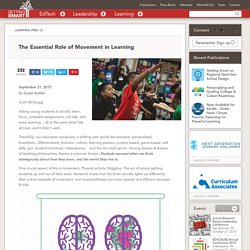
Why Kids Need to Move, Touch and Experience to Learn. When students use their bodies in the learning process, it can have a big effect, even if it seems silly or unconnected to the learning goal at hand.
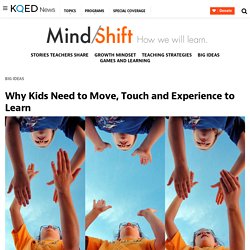
Researchers have found that when students use their bodies while doing mathematical storytelling (like with word problems, for example), it changes the way they think about math. “We understand language in a richer, fuller way if we can connect it to the actions we perform,” said Sian Beilock, professor of psychology at the University of Chicago.
Consider this word problem: Waking the Brain with Morning Stretches. You might remember a few weeks ago when I wrote about my take away from the Kagan training that I attended and how I was planning to Refocus Our Classroom.
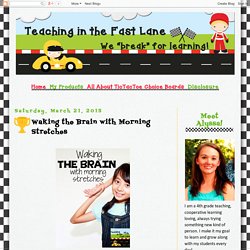
One of the big ideas that I touched on was waking up the brain through big muscle movement. So this month for the Bright Ideas link up I am sharing how it is going. The short version is that it is amazing! 3 Genius Tricks for Using GoNoodle as Bait. What is more motivating than a classroom dance party, yoga break with Maximo or ninja training session with Koo Koo Kanga Roo?
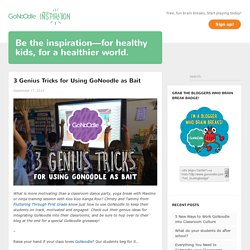
Christy and Tammy from Fluttering Through First Grade know just how to use GoNoodle to keep their students on track, motivated and engaged. Check out their genius ideas for integrating GoNoodle into their classrooms, and be sure to hop over to their blog at the end for a special GoNoodle giveaway! Raise your hand if your class loves GoNoodle? Our students beg for it… It’s no secret most classes who try it, quickly become obsessed with GoNoodle Brain Breaks…And as long as we aren’t telling secrets, their teachers kind of love it too! As teachers we recognize the need for our students to move. Tips to Get Kids Moving in Math - Bonnie Kathryn.
Numeracy is one of those important foundational skills taught in the kindergarten classroom.
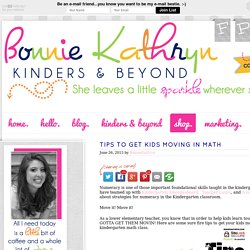
Brain Breaks Old School & Kindergarten Style! - Simply Kinder. Double Doodle Art. Sensory Break Ideas for Kids. 10 Crossing Midline Exercises For Kids - Golden Reflections Blog. PE Central: The Web Site for Health and Physical Education Teachers. PE Central: The Web Site for Health and Physical Education Teachers. Teach A Healthy Body, Get A Healthy Mind. Music and Dance Drive Academic Achievement. Narrator: These first-graders are learning all about opera… Class: [applauds] Teacher: Let's give them a round of applause.
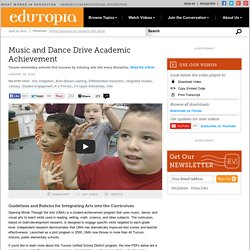
Take a bow, guys. Narrator: ...and with the help of professional singers and musicians, they're also becoming writers. Teacher: How does Papageno feel in the beginning of the story? Student: Thrilled. Teacher: Very good. Student: Exuberant. Teacher: Exuberance, very good. Narrator: At Corbett Elementary School in Tucson, Arizona, the arts enhance instruction in math, reading, writing, science and social studies. Teacher: What words do you use when you're at the end of a story?
Student: Finally. Teacher: Finally, very good. Classroom Exercise Makes Learning Lively. These techniques are wonderful for raising the students' energy level, for relaxing them.
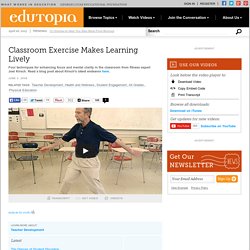
They can be done with the entire class at the beginning of class which is the best time to do it or if kids are losing focus or they're tired, you can, if you give the kids permission, they can go off to the side of the room, take a few minutes to do any one or a series of these techniques to get refocused and re-energized and then go back to their work. You take what's called the athletic ready stance, where your feet are comfortably apart, little wider than shoulders width, the knees are slightly bent and the back is straight. And this technique, you simply rotated the hips with the arms flopping out from the body, your head turns with your shoulders.
You don't force it though. But the hips lead. The palms pushed together here in a nice symmetric fashion and the knees are slightly bent.